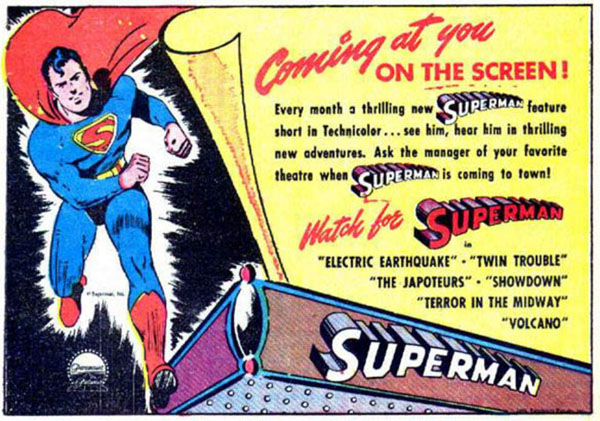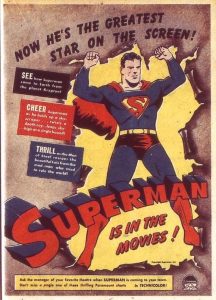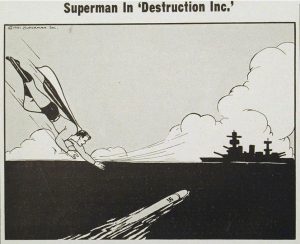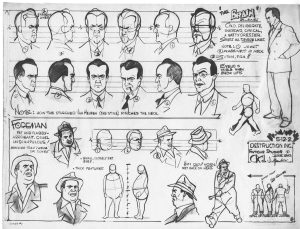
Dave Tendlar in later years at Hanna Barbera
Suspended Animation #376
Dave Tendlar born August 8th,1909 did animation and direction among other things from the 1930s through the 1970s for a variety of studios including Fleischer, Famous, Terrytoons, Filmation and finally Hanna-Barbera. He also illustrated funny animal comic book stories. He passed away September 9th, 1993.
While many animation fans are familiar with his work on the Fleischer Popeye animated cartoons, Tendlar also worked on the Fleischer Superman series and on the character for Filmation (The 1968 Batman/Superman Hour) and Hanna-Barbera (The 1977 All New Superfriends Hour, the 1978 Challenge of the Superfriends and the 1979 The World’s Greatest Superfriends).
The following remarks by the animator were culled from a series of interviews he did between 1989 and 1992 with writer Jay Sumsion.

Dave Tendlar: I started at Flesicher as a painter. It was opaqueing, but now they call it painting. I was there a very short time but they reorganized Flesichers so I went to Krazy Kat for a couple of years. And then I went back to Fleischer as an animator.
When they went to Miami in 1938, I was a Head Animator. Head Animator at Fleischer’s was actually the director. But, of course, we never got direction credit. Dave Fleischer took all of that at the Fleischer Studios but he wasn’t director, really.
The Head Animator did all the work for creating the mood of the picture, did all of the poses, the animation poses, the rough sketch background and stuff like that, interpreting the script as to where the scene cuts were. I did all that.
 I worked with the background painter and I’d do background sketches, location shots and stuff like that. Then the background guy would design and paint backgrounds to match my sketches. Mainly I concentrated on animation poses and expressions for the characters.
I worked with the background painter and I’d do background sketches, location shots and stuff like that. Then the background guy would design and paint backgrounds to match my sketches. Mainly I concentrated on animation poses and expressions for the characters.
I did all the timing, all of the exposure sheets and I also did bar sheets for the musicians. I spelled the whole thing out on music sheets, all the action, and the beats and that was given to a musician to score the picture.
I worked with a team of anywhere between three to seven animators. The major project was Gulliver’s Travels but I also worked on Betty Boop and Popeye. Superman didn’t start until almost three years after we got there.
We were all very excited about it but it turned out to be so expensive, too expensive to continue so Paramount decided to stop it. I didn’t follow the comic books very closely but everyone knew about Superman. He could use incredible force to move an object, that sort of thing.
We just knew he was really super. Dave Fleischer got direction credit on all of them. He wouldn’t give that up for anything. The Head Animator and the animators did all the work but Dave always took direction credits.
I laid out one called Destruction Inc. (1942) and there was another one I can’t remember right now. I think Lois Lane was kidnapped by the bad guys and they were in a submarine. They stuffed Lois into a torpedo and they were going to fire the torpedo out of the submarine underwater. Of course, Superman became aware of all this and went underwater, grabbed the torpedo and rescued Lois Lane.


Working on the Superman cartoons was very different than Popeye. Superman was very realistic. You had to have perfect anatomy drawing and the characters were very realistic. We had model sheets that were done in an illustrative style. They were very fine illustrations but they were not very cartoony. They were done in a very straight style.
There was more preparation than for a Popeye cartoon. They planned a lot of effects. They were all really full of effects and that made them very expensive among other reasons. It took much longer to work on them. One drawing might take an animator several hours to do because it had to be so realistic. Today, they are classics.
 On Gulliver we used a lot of rotoscope but I can’t remember using rotoscope on Superman, certainly not to the same extent. In the picture I worked on we were going to have one scene that we photographed with a lot of people. It was a scene where Lois was being chased by a bad guy and we photographed that. They just used that as a guide. We didn’t actually rotoscope that.
On Gulliver we used a lot of rotoscope but I can’t remember using rotoscope on Superman, certainly not to the same extent. In the picture I worked on we were going to have one scene that we photographed with a lot of people. It was a scene where Lois was being chased by a bad guy and we photographed that. They just used that as a guide. We didn’t actually rotoscope that.
We had very good artists working on them. They were very good at doing layouts and doing realistic types of things like buildings, scenes, weapons, and things like that. Very fine art work went into it as opposed to some of the crude stuff that we did on the Popeyes.
I can’t remember us being told to make an effort to make them look like the comic books. The scripts described the settings, the locations and stuff like that and the story/sketch men would follow the script. They made the drawings and the locations just as the scripts would describe and that’s why it all seems to work.
I think many of the animators were interested in the work because it was so very different from what they were normally working on. It was so different than the usual stuff, the usual Popeye type of slam bang slapstick stuff. It was just so interesting to work on.
I don’t recall going to a theater to see them. We used to see them at the studio. When they were finished they used to project them. Paramount decided that they didn’t want any more while we were still in Florida.
 I went to Filmation around 1968 and worked on The Batman/Superman Hour. I worked mostly on Batman, Robin and the incidental characters Catwoman, The Joker and characters like that. I did work on some Superman but mostly Batman.
I went to Filmation around 1968 and worked on The Batman/Superman Hour. I worked mostly on Batman, Robin and the incidental characters Catwoman, The Joker and characters like that. I did work on some Superman but mostly Batman.
I didn’t want to do any direction anymore. It was too much work. I just wanted to animate. For me, directing took all the fun out of cartoon making. There was just too much pressure and I was much happier just being left alone to animate.
Then after a couple of years I moved over to Hanna-Barbera and wouldn’t you know it, I was working on Superman again. By that time I was familiar with the requirements of drawing Superman.
There was really no comparison between the Fleischer Superman and those other studios. The Fleischer stuff had so many effects in it, so many different angles and very interesting scenes, explosions and that type of thing. You couldn’t do that kind of stuff at Filmation or Hanna-Barbera. It was much more of a cut-and-dried type of thing.
The Superman they did at Filmation and Hanna-Barbera was very crude compared to the Fleischer stuff which is very obvious when you see it on the screen.
Superman has always been very popular. I think that he will always remain popular. He has always been a very valuable property.


 Jim Korkis is an internationally respected animation historian who in recent years has devoted his attention to the many worlds of Disney. He was a columnist for a variety of animation magazines. With his former writing partner, John Cawley, he authored several animation related books including The Encyclopedia of Cartoon Superstars, How to Create Animation, Cartoon Confidential and Get Animated’s Animation Art Buyer’s Guide. He taught animation classes at the Disney Institute in Florida as well as instructing classes on acting and animation history for Disney Feature Animation: Florida.
Jim Korkis is an internationally respected animation historian who in recent years has devoted his attention to the many worlds of Disney. He was a columnist for a variety of animation magazines. With his former writing partner, John Cawley, he authored several animation related books including The Encyclopedia of Cartoon Superstars, How to Create Animation, Cartoon Confidential and Get Animated’s Animation Art Buyer’s Guide. He taught animation classes at the Disney Institute in Florida as well as instructing classes on acting and animation history for Disney Feature Animation: Florida.




















































About that “The Brain” model sheet, is it a caricature of Dave Fleischer ? It certainly could be that way, except for the mouth. Or is it someone else ?
That doesn’t look like Dave Fleischer to me. While it’s possible these models could be inspired by other employees at the studio, let’s keep in mind not all humanoid characters in cartoons are caricatures.
You think it doesn’t, I think it may. It’s all very subjective ! 😉
Yes it is – let’s let others weigh in. Below is Dave Fleischer surrounded by the two men on the model sheet in question.
We can agree on that both could either be caricatures, or not. And you’re right, Foreman’s mouth is closer to Fleischer’s.
I think that if a villain in “Destruction Inc.” had been consciously modelled after Dave Fleischer, Tendlar would have mentioned it in this interview. That’s the sort of detail he wouldn’t have forgotten, and animation fans would have loved to hear about. Fleischer/Famous didn’t really indulge in portraying its staff in cartoons, as some other studios did. One could make a more convincing case that Betty’s parents in “Minnie the Moocher” are based on Max and Essie Fleischer, but they look like a standard middle-aged immigrant couple to me.
If Dave Tendlar worked on another Superman cartoon for Paramount besides “Destruction Inc.”, he wasn’t credited for it. “Destruction Inc.” is one of the minor entries in the series, with Superman spending most of it disguised as a night watchman. Strangely, he stops an out-of-control dynamite truck by getting in the cab and steering it off a cliff. The Superman I know would have just grabbed the thing and thrown it into the middle of the ocean.
Still, it has an outstanding action sequence where the two saboteurs are chasing Lois through the rafters of the munitions factory. If, as Tendlar suggests here, the scene was first photographed in live-action, it must have been quite a challenge to stage.
A lot of people today denigrate the Fleischer/Superman cartoons as old-fashioned, corny and ridiculous. Yet when they first came out they must have seemed ultramodern, embodying the deepest hopes and fears of the time. Certainly few cartoons shorts have tapped the potential of the medium to the same extent. Tendlar was right: they are classics.
Are there any other examples of animators who animated the same character at three different studios?
That’s a fun question to ponder.
Would Virgil Ross count? He animated Daffy Duck at Warner Bros. – then later for Format Films, and after that for the new WB studio under Bill Hendricks. Then for Filmation – and later for Friz and Greg Ford for their compilation features.
I was wondering if perhaps someone might have animated Oswald for Disney, Winkler, and Lantz, or Felix for Sullivan, Van Beuren, and Trans-Lux.
Corny? No. Ridiculous? Heck, no. Those cartoons will never grow old, at least to me.
Dave Tendlar designed the gorilla for Terror On The Midway. Back in the early 1970’s I interviewed Dave Tendlar for several hours and i found him to be gracious, and polite and forthcoming. He did not mince words about individuals he thought were talented and those he thought were not. I still have the audio tape cassettes someplace and I guess I’ll have to rummage around and find them.
Love Tendlar’s Popeyes; most mumbles per minute from among the three main directors, if I’m not mistaken.
I’d been aware for many years of how Fleischer on-screen credits work, ie, the first listed “animator” is the actual “director.” But I’ve never understood exactly what Dave Fleischer contributed to any given title. Reading suggests that while he was a playboy after hours, he did put in a full workday at the studio.
But what did he do, precisely? (Besides act as Koko for rotoscoping.)
The cartoon with the “fake Superman” – SHOWDOWN – in that one, the “boss” DOES look a bit like Dave Fleischer, if you ask me!
Dave Fleischer supervised the stories and particularly, directed the voice actors and supervised the music as well. Dave Tendlar told me that once Dave Fliesicher put the “OK” on a film, the head animators could not make any changes.
The SUPERMAN cartoons are notorious for their “rotating screen credits.” The idea was to credit just about every unit who worked on the SUPERMAN cartoons, but quite often, the unit credited for a particular cartoon was not often the group who did the animation – similar to the earlier BETTY BOOP cartoons!
Gordon Sheehan told me that Willard Bowsky’s group did the first SUPERMAN cartoon. While Bowsky’s unit is credited for The Arctic Giant, where a Godzilla-like prehistoric monster unthaws and fights SUPERMAN, Gordon told me that Bowsky and Co. did not work at all on that film. I think he did remember that he worked on DESTRUCTION, INC. and SUPERMAN AND THE VOLACANO when he was working under Dave Tendlar’s unit.
While I’m here, I might as well give an advance “plug” for my upcoming book! I’m finishing up a two book project of interviews and articles I’ve done over the past 40 some years. The tentative title for the first book is BLUTO, BUSTER AND THE BLOB – which features several interviews I did with Jackson Beck, among others. The second book covers more animation – interviews with animators Shamus Culhane, Dave Tendlar, Gordon Sheehan, etc. – including TINY TOONS and ANIMANIACS animator, Jon McClenahan! The manuscript is being “laid out” right now with images and captions. I’ll say more – hopefully – when it’s all ready to be released!
I notice in that first ad for the Paramount Superman shorts the titles are a cross section of those released under Fleischer’s name and under Famous Studios. There’s also one titled ‘Twin Trouble’ which one would think might have been a working title for ‘Showdown’ but that title is listed too.
I wonder if ‘Showdown’ was originally planned to be the title of a different short (maybe one that was scrapped?) and was later given to the ‘Fake Superman’ story.
When I first saw Fleischer Superman, in the 7th grade, it was at a Houston mini-con in the 1970s – and my friends and I couldn’t believe how amazingly cool they were. I think the first one they showed had the magnetic telescope death ray, which had Superman physically punching the energy beam itself into submission with his fists. Old fashioned, yes – corny, yes – and more exciting and higher quality than any Superman cartoon we’d ever seen or would see.
When it comes to the discontinuation of the series, I do believe the cost of production was a big factor, but I’ve also heard that they just lost popularity with moviegoers by the end. Was Superman not a big thing anymore in 1943?
I’ve also entertained the idea that the move back to New York might have also been a cause but this is just my head going places.
Superman was a still a HUGE thing in 1943 – and beyond. They did two seasons of incredibly expensive cartoons. The war was on. The Paramount studio began a move back to New York.
Let’s remember that the Superman radio series was still on the air – a huge hit during the 1940s. The comic book sales were still tremendous. When Paramount’s movie rights expired, Columbia Pictures jumped in to produce two incredibly popular theatrical serials (1948 and 1950). The iconic TV series with George Reeves started in 1951 (with a movie)… it only ended with Reeves suicide. Superman went to Broadway in 1966 – and Batman’s 1966 TV series knocked Superman down briefly (though the Superman/Aquaman Filmation shows began his presence on Saturday Mornings for decades to come)- and since 1979’s Chris Reeve Superman movie blockbuster the character has never been out of sight or out of mind.
So no, I don’t think they stopped making the cartoons because Superman wasn’t a “big thing” in 1943.
Do you know if the budget remained the same as the production went on?
Clearly the budget was cut in the second season – the Famous Studios season.
Does anyone believe that the Superman cartoons were not rotoscoped a lot more than Dave Tendlar remembers? (Let’s not keep seeing the same hands.) In fact, that’s the series’ biggest weakness: for however expensive they were, aside from a few dramatic camera angles and some special effects, they look like cheesy low-budget live action shorts traced over in drab Technicolor. The tinny soundtrack and dull voices that fail to bring the characters to life don’t help, either. Still, they should have made a feature instead of shorts; perhaps by that time Paramount was already plotting to dump the Fleischers and take over the studio so they insisted on this project that was guaranteed to lose money.
Cheesy low budget? Bah! I thought they were quite good and apprantly better than the Columbia live-action serial from what I hear. If it weren’t for them, we wouldn’t have somthing like Timm and Dini’s Warner animated series (including their own Superman).
I have heard that the Flesisers studio was planning to do Batman before they closing. I wonder if they be successful and a bit dark like the comics at the time.
“Tinny soundtracks and dull voices”? I beg to differ! I think you’ve seen some crappy prints of these films – and there are a lot of them out there! A little more than a few decades ago – you may remember – the only thing collectors could generally see were old black-and-white TV prints! Gordon Sheehan ran a nice color 16mm print he had of the first SUPERMAN cartoon and the sound and colors were terrific! (Better in fact, than many so-called “restored” copies I’ve seen on VHS and DVD over the years!)
The Fleischer’s hired the radio actors to do the voices – Bud Collyer, Joan Alexander, Julian Noa. etc. I questioned Jackson Beck several times about any voice work that he may have done on them – but he doesnt remember doing any of the later ones for Famous Studio. That’s a question, because the IMDb lists Beck in the credits on a lot of them. He didn’t start working at the studio until around 1944 – as far as I’ve been able to pin down!
I’m sure Gordon Sheehan or Dave Tendlar would have mentioned a BATMAN series if there were real plans to do one. Gordon remembered that Bob Kane had very briefly worked at the studio as a teenager – either before or while he was working on BATMAN, but I haven’t found clarification on this.
I also haven’t gotten a clear picture on the actual costs of producing the SUPERMAN shorts at Fleischer’s. Gordon told me that they slashed the budgets way down when the studio was taken over by Paramount and the staff moved back to New York from Miami, Florida.